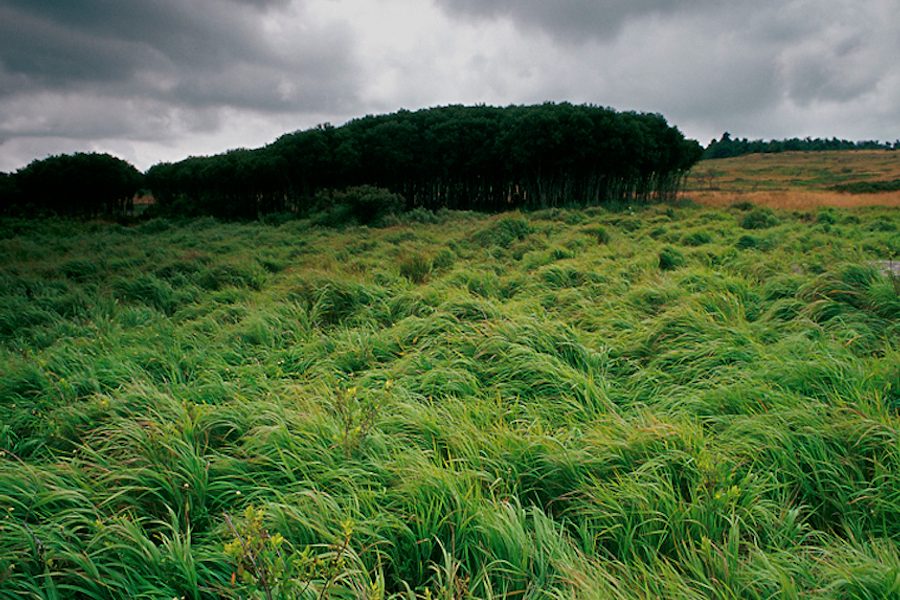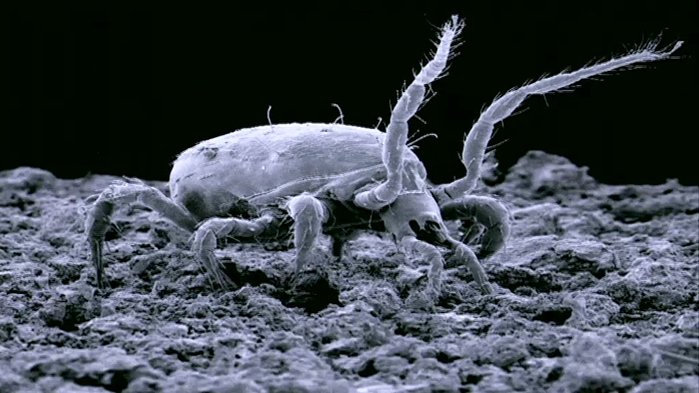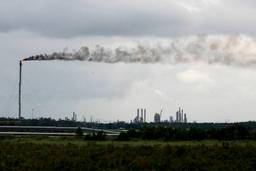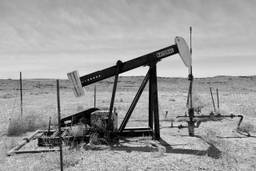Soil is Life: Herbivorous Solar Conversion and Carbon Sequestration in the Shenandoah Valley
Joel Salatin

Soil is a world. A community of beings as unbelievable as you can imagine. If you could go out right now and look at the soil through an electron microscope you’d see this kind of 4-legged-aqueous-cow creature walking along, splashing and eating cilia and paramecium and all this other stuff. Then, all of the sudden from 10 o’clock, in runs this narwhal 6-legged thing who pierces the four-legged cow-looking thing and, fthhhh, sucks out the juices. And then while this aqueous-cow-looking-4-legged critter is sitting there, desiccating — being sucked into the straw by this narwhal thing — in comes an 8-legged critter from 2 o’clock running into the electron microscope you’re looking into. He has scissors on the top of his head and whacks off the head of the cow-looking thing and, thp thp thp thp thp thp thp, eats it up. And all this happens in a fraction of a second in the electron microscope while you’re looking at it. This is what’s going on. It’s out there happening billions and billions of times a second. Everywhere we step, everywhere we are. And yet, who thought about this world in their shower this morning?
That’s the problem. Who goes into a bank for a loan with a business plan and the banker sits back and says, “Hey, this is a really good idea. In fact, it’s such a good idea I think I wanna be your pahtner (I’m from the south, sorry) but before I give you this half a million dollar check for your capitalization fund, I have one question: ‘What will this business do to the earthworms and the mycorrhizae in our community?’ “
Does anybody ever ask that? One of the problems in our culture is that we do not have an accounting system that measures the externalized impacts of our decisions. In fact, we measure our gross domestic product (GDP). If you ruin the soil and pollute the water and destroy our juveniles so they all end up in jail, all the remediation efforts redound to a societal asset called GDP. It’s an insane accounting practice.

(Did somebody say $500,000? Google Images)
The Knights of the Golden Horseshoe
I’m from the Shenandoah Valley in Virginia, it’s 80 miles long, 20 miles wide and east of the Blue Ridge Mountains. It was known as the breadbasket of the Confederacy during the Civil War. But if you go back, we had this governor before the Revolutionary War named Alexander Spotswood. In the early 18th century, the British had come and they’d landed on the east and they’d moved west, west, west into Charlottesville. They hit the Blue Ridge Mountains and they didn’t go beyond that. In the early 1700s a lot of riff-raff — these Germans, Scots-Irish, you know — were coming down from Pennsylvania and New York (yeah we had Yankees then too) and settling in the Shenandoah Valley. Spotswood was afraid he was going to lose the valley and what was beyond there. So in 1716, he sent about 10 buddies (he called them the Knights of the Golden Horseshoe) across the mountain. He said, “go over to the valley and scope it out, tell me what you find.” They went over to the valley and they wrote back: “Everywhere we rode in the valley, we could take the grass and tie it in a knot above the horse’s saddle.”
It was a magnificent alpha soil silvopasture. Maintained by the Native Americans, and fire, and great migratory herds of buffalo, elk, prairie chickens, turkeys, pheasants, bird, herbivore, with a little bit of cultivation from the three sisters — the beans, the squash, and the corn. And that was what built these soils. In fact, all the deep soils on the planet were not built under trees or under bushes — they were built under grass with the help of herbivorous and predatory migratory patterns.
And so this grass grows in a sigmoid curve — an s-curve. It starts slow then it grows fast and then it slows down and goes into senescence. I call the first part diaper grass, the second part teenage grass, the third part nursing home grass. The way nature works with the buffalo and other herbivores; the reason there are herbivores all over the planet — from llamas and alpacas to zebras to caribou to buffalo to cows to goats to sheep — is because this s-curved biomass, if left unpruned, simply falls into senescent nursing home stage and volatilizes its carbon and doesn’t get restarted into this rapid metabolic sunbeam conversion into carbon sequestration.
Nature, in order to restart this rapid biomass accumulation has the herbivore come along, right as it goes into senescence. That’s when all the carbohydrates and sugars are high enough to feed these four big sauerkraut vats in this four-legged portable mowing critter. The herbivore is a great big portable sauerkraut vat that takes in this biomass, ferments it inside, and turns it into meat and milk and bone and hide and all sorts of things. For the Native Americans the buffalo was a walking supermarket. It was their shelter, their instruments, their tools, their food — everything.
This is how nature works. And it’s fundamentally carbon-centric. When the Europeans came into the Shenandoah Valley they saw this beautiful, tall grass and this beautiful alpha soil and they brought with them a grain-based, annual-based economy. They didn’t take time to ask the Natives, “How have you built this for millennia?” They simply translocated their holy grail of grain. Historically, grain has always been expensive. In the bible, it talks about a harlot being sold for an ephah of barley — it’s not because harlots were cheap. Tillage was very difficult to maintain, very difficult to do, and it was very difficult to then keep the grain away from rats and vermin in a time before storage containers, sheet metal, mesh steel and those kinds of things. This is the first time in human history grain has been cheap. The food of the commoner (seafood in some cases) has always been herbivore, animal-based. This is because they are nutrient-dense and actually move in real-time without requiring refrigeration — thus allowing a family to move without carrying a bunch of lentils and grains in a pot. Trust me, when Daniel Boone went to visit Kentuck he wasn’t carrying watermelons and zucchinis on the back of his saddles, he was carrying meat. It’s why all impoverished cultures in the world have an animal-based agrarian foundation under them: When you’re relocated, when you’re invaded and you have to move or you have to flee, you can take a cow with you or a goat and milk it in real-time for nutrients for your babies. When you don’t have refrigeration, you can’t just carry a bunch of lentils and beans around. Animals are critical.

Native Americans hunt bison in a painting by George Catlin.
Animals move
When we came to this farm it was gullied and worn-out — a rockpile. It was the armpit of the community. It only generated about 10,000 dollars a year (a quarter of a salary) and couldn’t produce anything except maybe 20 cow-days per acre. So we looked at that piece of land and asked, “How does nature work?” We looked at these templates in nature and saw that nature builds soil with perennials not annuals. We realized an agricultural economy that actually works should be centered on perennials not annuals. And yet everything about U.S. ag policy promotes annuals not perennials. Our entire agricultural system is funding and concessionizing and subsidizing land degradation.
Important: There is no animal-less ecology. There is no ecosystem that functions without animals. We now have a vegetarian/vegan rise that assumes that we can abdicate this animal-centric role in ecosystems and think that everything can just run on vegetable matter. It can’t, it doesn’t, it never has. All functioning ecosystems have animals. How do these animals work? They move! Amazingly, today in our culture we don’t think animals are supposed to move. We think they’re supposed to be locked up in a confinement factory. But in ecosystems animals move and harvest biomass over here, poop it out over there and create democratized fertility opportunities for the biomass area that they live in. Nature can’t move fertility uphill except by a bird flying up or an herbivore walking up there and pooping. It’s a gravity defying process.
There’s a very visceral, significant role of animals in nature to democratize soil/plant opportunity. How are you going to move the fertile valleys to the hilltops in nature? You’re going to do it with predators, both 2-legged and 4-legged, which cause herbivorous animals to instinctively want to eat down here and lounge up there so they can look out and see who’s gonna get them. The predator, the beautiful predator-prey choreography that sounds violent to us, is actually the nurturing caress of the womb holding democratized fertility in place.
Polyface Farms: A reverse economy
So, we understood we had to have animals and that they needed to move around. But how? On our farm, we’re using high-tech electric fencing to biomimic the great migratory patterns of herbivores throughout nature. Every day at 4 o’clock we move the herd — 500, 600, 800 strong — to the next paddock. We call this mob-stocking-herbivorous-solar-conversion lignified-carbon-sequestration-fertilization. And if every farm in America that had livestock would practice this it would build so much soil, humus and organic matter that in fewer than 10 years we would sequester all the carbon that’s been emitted since the beginning of the industrial age.
Well, the next thing we asked was, “How do we build soil?” Soil’s not built with 10−10−10 chemical fertilizer, it’s built with carbon. So we got a wood chipper and began composting. But we don’t compost with big machinery. We add corn, the corn ferments in the bedding pack and we put the pigs in. If you look at any pig you’ll see “will work for corn” written on its forehead. The pigs seek the fermented corn, aerating and oxygenating the whole pile. When you let the animals do the work, they become not just bacon and eggs and t-bones, but co-laborers and fellow ministers in a great land-healing project. And the pigs don’t need their oil changed — they don’t need spare parts or social insecurity — when you’re done with them, you eat them. It’s a wonderful relationship.
So, we used this compost and we started to see the grass grow. We saw the bare gullies heal over and the rock piles start to disappear Soil builds up, it roils like over a wound. Over time, since 1961, the rock piles and gullies have healed. Some are still thin-soiled, but the whole farm has become a productive verdant area producing up to 400 cow-days per acre and generating half a million dollars in income on the same acreage that half a century ago could only produce 10 cows and 10,000 dollars a year.
We call ourselves the reverse economy. We are pulling money out of the urban sector and plugging it into the rural economy instead of the other way around. Most economies work on depleting the rural wealth to ingratiate the urban wealth. We’re bringing it back the other way. And we’re bringing labor back to the farm. We have a team of 20 people involved in moving all this stuff around. We are trading drugs and capital-intensive stationary infrastructure with labor, management, and local customers. We don’t apologize that our system takes more labor. It won’t in the long run because there’s nothing to heal from externalized oopses. This system provides real-time labor for real sacred ministry in a real place anchored to a real umbilical in a visceral connectedness. That’s what it does. And that enables both our team and our customers to participate in ecological healing.
The motto on our little baggies is “healing the land, one bite at a time.” And ultimately, our position is that we need to be environmentalists by participation not abandonment.
I get the guilt complex. The story of history of civilization is too often the story of abuse, conquistador mentality, rape and pillage. I understand that. But the answer is not to extricate humans from the landscape. It is to take our big brain and mechanical ability and view our landscape and use our hands as a masseuse not a rapist. On our farm, the response has been magnificent. We have a mentality in our country that suggests nature is some reluctant partner that we have to force and wrest and get in a headchoke to make grow. Our view is that nature is a benevolent lover that responds to our success. This is not a place of scarcity. If we learn to respect and honor nature— come to it with the kind of humility, respect and sacredness that it asks us to — we will discover a place of unimaginable abundance.
This is not difficult folks
Imagine, in your wildest imagination, if all the petroleum chemical fertilizer used in Virginia were instead rechanneled into a carbon-centric composting soil-building program. Think of the job creation, think of the wars we wouldn’t have to fight to keep oil cheap, think of the petroleum that would stay in the ground, think of the hydration that would happen and the floods that would not happen. One pound of organic matter holds 4 pounds of water and the best way to hydrate the landscape (and we are in a place that needs landscape hydration let me tell you) is to increase organic matter.
On our farm, we’ve gone from 1 percent organic matter to 8 percent in 50 years. All we have to do nationwide is go from 1 percent to 2 percent and we would mitigate all the carbon that has been emitted since the beginning of the industrial age. This is not difficult folks! The tragedy of our time is not that we’re lazy and not that we’re ignorant. The tragedy is that we’re busy about the wrong things. We’ve learned how to grow corn with GMO technology and GPS technology — driverless tractors manipulated by computer banks a thousand miles away in a 5th floor office building in the city — but nobody’s asking, “Why should we grow that corn?” We’ve become, as Stan Parsons, author and founder of the Ranching for Profit Schools, says, “extremely good at hitting the bullseye at the wrong target.”
Trust me, if all of the money and time and energy that’s gone into Los Alamos had gone into permaculture, high pond building, water mitigation and carbon-centricity agriculture, the southwest would be an Eden — floodproof and droughtproof — and we could have led the world into a redemptive landscape capacity. This is a goal and a vision that starts with soil and our connected biology. Every one of our cells has 3 bacteria hooked up to it. We’re really inhuman. And we’re pretty insignificant in the big picture of things. But we are the most significant hurter or healer depending on how we extend our hands. May God help us to extend them as a friend, not as a foe.
In the meantime
May all of your carrots grow long and straight. May your radishes be large and not pithy. May tomato blossom and rot affect your Monsanto neighbor’s tomatoes and not yours. May the coyotes be struck blind at your pastured poultry. May all of your culinary experiments be delectably palatable. May the rain come gently on your fields, the wind be always at your back, your children be wise and call you blessed and may we all make our nest a more magnificent place than we inherited.
(This essay was adapted from a speech Joel Salatin delivered at the 2015 Business Alliance for Local Living Economies (BALLE) conference in Phoenix, Arizona. The speech can be viewed in its entirety here. Rural America In These Times would like to thank Polyface Farms and Anna Ghosh @ BALLE for their assistance.)




